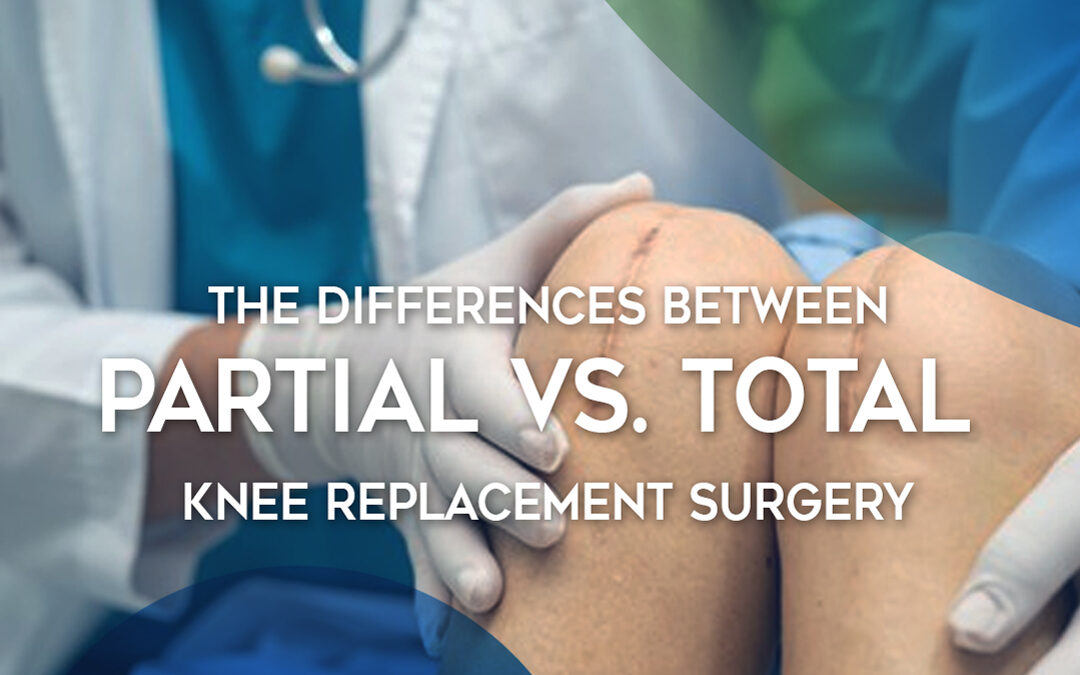Knee replacement surgery is one of the most common orthopedic surgeries performed in the United States. It also has a reputation as being one of the most successful surgeries for reducing pain and restoring mobility to patients with joint pain and damage.
Advanced osteoarthritis is the primary reason patients require a joint replacement procedure. Normal wear and tear, a past knee injury, or genetics can contribute to cartilage degeneration and progressive joint damage that causes pain, swelling, stiffness, and decreased mobility in the knee. Eventually, osteoarthritis can lead to difficulty walking and performing daily activities — key indicators that surgery might be the next treatment option to improve quality of life.
There are two types of knee replacement surgery: partial knee replacement and total knee replacement. Keep reading to learn the differences between the procedures and when each one is warranted.
Partial Vs. Total Knee Replacement Surgery
Knee replacement surgery is the final treatment option for patients with advanced osteoarthritis or debilitating knee pain. Surgery is only recommended once conservative treatments — like medications, physical therapy, injections, lifestyle changes, and assistive devices — have failed to significantly reduce pain and other symptoms. Non-operative treatments can slow down the progression of arthritis but can’t stop or reverse progressive joint degeneration. Eventually, severe wear and tear necessitates a surgical intervention.
Once surgery is on the table, your doctor will decide whether a partial or complete replacement surgery is the right option for your condition. Their assessment is based on the condition of each part of the knee. The knee joint includes three compartments: the medial compartment (inside of the knee), lateral compartment (outside of the knee), and patellofemoral compartment (front of the knee).
- Partial replacement. A partial replacement is recommended if only one compartment of the knee has damage or degeneration. During surgery, damaged cartilage and bone is removed and replaced with knee implants. A partial replacement surgery preserves the healthy cartilage, bone and ligaments in the joint.
- Total replacement. A total replacement is recommended if two or three of the compartments have damage or degeneration. During surgery, all joint surfaces are removed and replaced with knee implants. A total replacement surgery requires a partial or complete loss of natural cartilage, bone and ligaments in the joint.
Keep reading to learn who’s a candidate for each type of procedure.
Which Surgery Is the Best Choice?
Partial replacement surgeries are less common than total replacement surgeries. To qualify for a partial replacement, you must meet the following criteria:
- Damage contained to a single compartment
- Minimal or no joint deformity
- Intact ligaments
- Good range of motion
- Overall knee stability
A partial knee replacement preserves more of the joint’s original structure and healthy tissues, which can result in better function and range of motion following surgery. Additionally, a partial replacement has a faster and shorter recovery period. The biggest risk of a partial replacement is that joint damage and degeneration will progress to other compartments of the knee down the road — eventually requiring a second, total replacement knee surgery.
A total knee replacement is the better choice if you meet the following criteria:
- Damage spread across two or three compartments
- Severe joint deformity
- Ligament damage or instability
- Loss of range of motion
- Persistent pain even after non-operative treatments
As mentioned above, knee replacement surgeries have proven to be very successful at reducing pain and improving mobility in many cases. Additionally, prosthetic implant technology has vastly improved over the years. A total replacement implant is incredibly durable and can last for 15-20 years with proper care. The revision rate for total knee replacements is lower than the rate for partial replacements.
Is There An Alternative Option?
You may not feel ready to commit to surgery at all. Even though knee replacement surgery is very successful for many people, it’s not effective for everyone. A failed surgery leaves patients suffering from pain and loss of mobility after spending thousands of dollars and several months on the procedure and rehabilitation. Additionally, you run the risk of suffering from an infection, loosening hardware, a failed implant, or a future revision surgery.
If you have severe knee arthritis and you’ve been told you need joint replacement surgery, you may be a candidate for the iO-Core™ procedure. It’s a minimally invasive procedure that combines biologics with orthopedic techniques to address underlying bone damage and surface cartilage loss caused by arthritis.
Traditional arthritis treatments focus on treating the surface loss of articular cartilage. But studies have shown that underlying bone loss and undiagnosed bone marrow lesions are a significant source of pain, cartilage erosion, and accelerated degeneration in patients with arthritis. The iO-Core™ procedure targets the root cause of joint pain to relieve pain, restore functional mobility, and prevent future damage.
Many of our patients experience pain relief within one week following surgery. The procedure is covered by most insurance providers. Contact our team today to learn more and see if you qualify.

